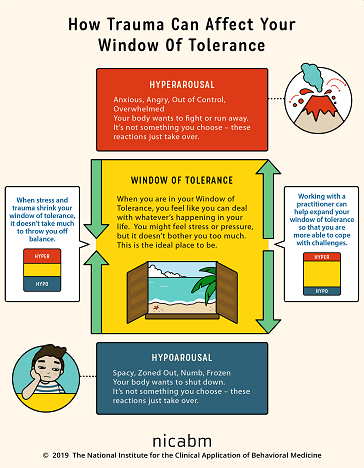|
Window of tolerance is a term used to describe the zone of arousal in which a person is able to function most effectively. When people are within this zone, they are typically able to readily receive, process, and integrate information and otherwise respond to the demands of everyday life without much difficulty.
When a person is within their window of tolerance, it is generally the case that the brain is functioning well and can effectively process stimuli. That person is likely to be able to reflect, think rationally, and make decisions calmly without feeling either overwhelmed or withdrawn. During times of extreme stress, people often experience periods of either hyper- or hypo-arousal. If the level of arousal is too high and jumps above the window of tolerance, a person is experiencing hyperarousal. Usually this is the initial response when a stressor throws one off balance. Hyperarousal comes from the fight-or-flight adrenaline response, which can show up with increased heart rate, racing thoughts, digestive issues, or hypervigilance in the surroundings. It might leave a person feeling an intense wave of anxiety, panic, or anger. The individual’s emotions can be overwhelming and out of control. If the level of arousal is too low and dips below the window of tolerance, this is hypoarousal. This comes from a freeze and shut-down response, often as a reaction to the adrenaline rush of hyperarousal. Hypoarousal can look a lot like depression. The person might notice lack of motivation, exhaustion, feeling numb, and emptiness. Hypo-arousal may leave a person feeling disconnected from emotions. In either of these states, an individual may become unable to process stimuli effectively. The prefrontal cortex region of the brain shuts down, in a manner of speaking, affecting the ability to think rationally and often leading to the development of feelings of dysregulation, which may take the form of chaotic responses or overly rigid ones. In these periods, a person can be said to be outside the window of tolerance. |
Each individual’s window of tolerance is different. Those who have a narrow window of tolerance may often feel as if their emotions are intense and difficult to manage. Others with a wider window of tolerance may be able to handle intense emotions or situations without feeling like their ability to function has been significantly impacted.
The window of tolerance can also be affected by environment: people are generally more able to remain within the window when they feel safe and supported. Most people move between these varying states of arousal from time to time. Trauma and/or extreme stress often make it more likely a person will become either hyper-aroused or hypo-aroused. |
|
|
|
|
|
Regulating Back into the Window of ToleranceBeacon House has a range of ideas for helping children calm or alert back into their window of tolerance. This is a great resource for practitioners, families, and schools.
Download the handout here. |


